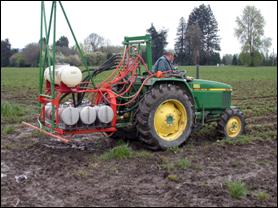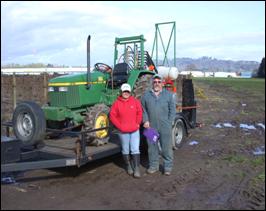Washington State University
Mount Vernon Northwestern Research and Extension Center
Mount Samples
Mixed root weevil larval populations, Burlington, WA.
The larval composition at a three year-old ‘Totem’ planting in Burlington was equally divided between the black vine weevil, O. sulcatus and rough strawberry root weevil, O. rugosostriatus, based on the size differences between late instar larvae sampled. Drench treatments of experimental Leverage™ (imidacloprid + cyfluthrin), were compared with Admire Pro™ (imidacloprid), Platinum™ (thiamethoxam) and combination of Platinum and Brigade with an untreated check. Each treatment was applied to a 30’ single row plot with 6’ buffers separating plots and replicated five times in a randomized complete block design. Treatments were applied on 21 April and 12 May 2008 with a tractor mounted plot sprayer equipped with a three row, low-pressure boom sprayer configured with three VeeJet 8030 nozzles, calibrated to apply 70 gpa at 40 psi at 1.8 mph. Both treatments were followed by approximately 140 gpa of water. Larval population levels were estimated from three soil cores taken per plot with a golf-green cup-cutter. The core samples were placed together in garbage bags and transported back to the lab and held at 50°F until they were examined by sifting through hand held screens. Data represent average root weevil larvae per plot based on three core samples. Average number of larvae/plot is shown in Table 1. At 11 DAT, larval counts for Admire and Platinum + Brigade were significantly different at 5% level from the untreated check. The Platinum + Brigade combination continued to show significant larval reductions after 18 DAT at 8.6 larvae. However, the number of larvae in the Admire plots averaged the highest level for all treatments at 18 DAT. Variability in the field data may be in part, attributable to the tendency of root weevil larvae to exhibit a clumped distribution. A second application 12 May was necessary because the root weevil larval populations were all comparable to pretreatment levels and nearing late instar/prepupal stage, making them increasingly difficult to kill. There was no significant reduction of the larval population at 32 DAT. We conclude that the April application date was too late for this field population to control maturing instar larvae.
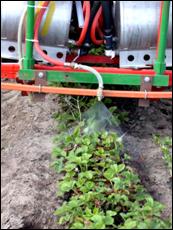
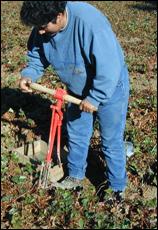
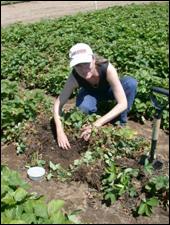
| Treatment | lb(AI)/acre | Mean root weevil larvae | |||
|---|---|---|---|---|---|
| Pretreatment | 11 DAT | 18 DAT | 32 DAT | ||
| Mean within columns followed by the same letter are not significantly different (Fisher’s protected LSD, P<0.05), PRC ANOVA SAS. | |||||
| Admire Pro | 0.5 | 29.4a | 0.0b | 25.8a | 27.4a |
| Leverage 2.7SE | 0.370 | 16.0bc | 20.4a | 14.6bc | 18.2ab |
| Platinum 2SC | 0.19 | 16.4b | 14.2a | 14.0bc | 11.0b |
| Platinum + Brigade WSB | 0.188 + 0.1 | 7.6c | 5.6b | 8.6c | 12.2b |
| Untreated check | 15.0bc | 21.8a | 20.8ab | 11.8b | |
Mixed root weevil larval populations, Woodland, WA.
The larval composition at a four year-old ‘Totem’ planting in Woodland was approximately divided 2:1 clay colored root weevil, Otiorhynchus singularis and O. raucus, respectively. These counts were based on adults collected in spring from soil-debris at the base of strawberry crowns. The experimental design, application method and sampling technique, were similar to the Burlington study above, however we did not apply the Platinum + Brigade combination which had performed well in the past as a soil drench.
On 16 April 2008, the efficacy of Admire Pro, Platinum and Leverage was tested against a mixed late stage (late instar larvae – prepupae) population of the two root weevil species, in southern Cowlitz County. Larval counts from core samples exhibited no significant differences between pretreatment and 12 DAT, suggesting the population continued to increase and the timing for an adult foliar spray within 7-10 after the last larval samples was an appropriate decision.
